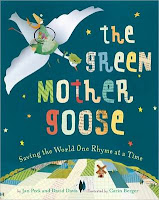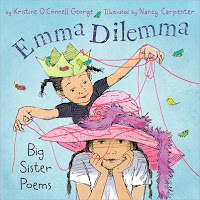
Graduate student Sharon Forinash created the following digital trailer for Spinster Goose; Twisted Rhymes for Naughty Children by Lisa Wheeler. It's so clever (actually both the book and the trailer are so clever)! Check 'em out.
And Veronica Grooms created a readers' guide for Spinster Goose full of fun activities. Check it out!
Bibliography : Wheeler, Lisa. 2011. Spinster Goose: Twisted Rhymes for Naughty Children. Ill. by Sophie Blackall. New York: Atheneum Books for Young Readers. ISBN 978-1-4169-2541-5
Recommended Age Level: 5 and up
Summary of the Book
In this delightfully sinister twist on Mother Goose, Lisa Wheeler has given us her recreated and reimagined parodies of the traditional Mother Goose rhymes by introducing a new character, Mother Goose’s sister Spinster Goose. When faced with the naughtiest, most rotten children around, Mother sends them on to her stern sister Spinster who rules over a prison-like school for wayward children. Here we find every manner of brat: the pinchers, pokers, biters, takers, swearers, cheaters, liars, and more! We have new delinquents along with some familiar ones like Jack and Jill, Georgie Porgie, Mary Quite Contrary, and Humpty Dumpty. Warning! Watch your manners. If you are not careful, “She’ll box and wrap each little brat/ and send them home to you!” Reminiscent of the horrid adults and situations in the books by Roald Dahl. Each poem is accompanied by morbid little pictures done in watercolor and ink. Sophie Blackall’s illustrated children are every bit as unique and recognizable as the artwork of Edward Gorey and Tim Burton. A standout aspect of her illustrations for the book is that her characters are truly whimsical—some human and some part animal. Georgie Porgie, for example, is a bullying bulldog picking on two cherub-faced little preschoolers. The rhymes and illustrations in this book are a perfect combination to tell the story of these beastly boys and ghastly girls. This will appeal to children and adults who like things slightly strange and off-center.
Review Excerpts
This website has an entertaining and enjoyable review in the form of a video book trailer: http://www.ratchatreviews.com/?p=656
STARRED REVIEW in KIRKUS
“Delectably satiric nursery rhymes play with naughtiness and punishment. Mother Goose sends disobedient children (some human, some half-animal) to her sister Spinster Goose’s reform school, where “The pinchers get pinched, / and the pokers get poked. / The biters get bit, / and the smokers get smoked.” Crimes range from eating chalk to stealing sweets and cheating. Some consequences arise naturally (gum-chewer’s gum explodes on her face), while others come at Spinster’s strict hand: Baa Baa Black Sheep swears, so Spinster “hires shearers from the north, / hygenists [sic] from the south. / They promptly shear his BLEATING wool, / then wash his BLEATING mouth!” Real violence remains mostly at rumor level as threats—an electric chair and stretching rack are shown but not used. Lard-boiled beans prove that “Life is Gruel”; deliberately filthy Polly Flinders refuses to shower because “this punk is into Grunge.” Badness was never more enjoyable than Wheeler’s wicked rewrites: "Friday's child stole seventeen lunches. / Saturday's child threw seventeen punches. / But the child who got a Sunday detention / did something too naughty for me to mention." Blackall’s watercolor-and-ink illustrations are fascinatingly delicate in line and color as they convey all the funny, delicious ghastliness of necks bending in woe, cheeks paling in nausea and this whole mob of unbiddable, hybrid Struwwelpeter/Gorey kids.”
—Kirkus 2011
This collection of Mother Goose parodies . . .is as elegant as it is, like Mary, “quite contrary”….Blackall’s pallid vignettes balance chilly poise and mordant humor. . . Wheeler adds some intellectual depth to the original nursery rhymes while grossifying them. . .kids with a twisted sense of humor will feel right at home.
—Publisher’s Weekly 2011
. . .Blackall backs up the rhymes with wry, devilish images that surround, infiltrate, and help spark this offbeat collection. Pairing these parodies with a traditional Mother Goose book . . .will help expand listeners’ appreciation of Wheeler’s humor. —School Library Journal 2011
Questions to Ask Before Reading Book
1. Has anyone heard of Mother Goose?
2. Do you know any Mother Goose rhymes?
3. Would you like to share and recite the rhymes you know?
4. What do you think of Mother Goose? How do you picture her?
5. Looking at the cover of Spinster Goose, does this look like Mother Goose? Who do you think this is? Does she look kind or mean? Why?
6. What is a spinster? What do you think of when you hear that word?
7. Why is she holding the children like that? What kind of children are they?
Suggestions for Reading Poems Aloud
• Invite the children to pick their favorite traditional Mother Goose rhyme or their favorite from Spinster Goose and to recite it aloud using costumes and props. For example, “The Fibber” by Lisa Wheeler (Spinster Goose) could be read by a female student dressed like Mary and with a stuffed lamb prop. “The Custodian” by Lisa Wheeler (Spinster Goose) could be read accompanied by a bucket and mop
• The children could be encouraged to read a rhyme as a duet. A perfect example would be “The Interrupter” by Lisa Wheeler (Spinster Goose). This rhyme has alternating lines: the actual rhyme and then the interjections of the character Mary (Mary, Mary, quite contrary). One child could narrate the rhyme, the other could play the part of Mary. The part of Mary would need to sound like an annoying know-it-all!
Mary, Mary, quite contrary, she’s a walking dictionary. “I think you mean encyclopedia.”
• Let the children read their favorite rhyme from Spinster Goose using several different accents, emotions, and tones of voice. For example, “Crooked Row” could be read with a very proper, upper-crust British accent, with a scary, sinister voice, or with a cheerful, peppy voice similar to the Good Witch in the Wizard of Oz movie. Let them have fun and experiment with how one’s voice can change the presentation and characterization of the poem being read aloud.
Follow Up Activities (From Activity Guide on lisawheelerbooks.com)
Science
1. Poem: The Gum-Chewer Pg. 8
Good Books to pair with this poem:
Pop! The Invention of Bubble Gum by Meghan McCarthy
Bubble Gum, Bubble Gum by Lisa Wheeler
Bubble Trouble by Margaret Mahy
BubbleMania: A Chewy History of Bubble Gum by Lee Wardlaw
The BubbleGum Kid by Stu Smith and Julia Woolf
Science Experiment:
Supplies: 6 or more brands of bubble gum
Question: Which brand of gum makes the best bubbles?
Come up with a hypothesis. Do the kids think that more sugary gums make the best bubbles? Does the color of the gum matter? Etc.
Using at least 6 brands of bubble gum, have teams of students chew and blow bubbles.
Measure bubbles carefully and accurately .
Time the length a bubble lasts before popping or deflating. Which gums made the strongest bubbles? Biggest bubbles? Longest lasting bubbles?
Chart the results and compare with the other teams.
2. Poem: The Chalk-eater Pg. 12
Science experiment: Supplies: White chalk, vinegar, clear drinking glass
Question: How long will it take chalk to dissolve? Place chalk into the glass half-full of vinegar
Observe. The chalk will begin dissolving and be completely dissolved within a few days.
Ask students, “Why did the chalk dissolve?”
Research what the vinegar and lemon juice are (acid) and the properties of chalk (calcium bicarbonate.)
Why is chalk ‘non-toxic’? (It is made from ground limestone, clay, water, and non-toxic dry coloring powder.)
Can we make calcium bicarbonate? (Mix soda water, calcium pills and baking soda.)
Language Arts
1. Poem: The Cheater Pg. 32
Parody: a piece of writing, music, etc., that imitates the style of someone or something else in an amusing way.
Compare this parody with the original poem.
Explain the meaning of ‘parody.'
Original:
Peter, Peter, pumpkin eater
Had a wife and couldn’t keep her.
He put her in a pumpkin shell,
And there he kept her very well.
*Note that the entire book, Spinster Goose: Twisted Rhymes for Naughty Children is a parody of Mother Goose.
2. Poem: The Fibber Pg. 39
Using “Mary Had a Little Lamb” as a pattern, write a new poem. Here is a pattern to follow:
________had a little_______. His/her _______ was ________ as _______. Everywhere that __________ went / The_______ was sure to _______.
Example:
Justin had a little fish.
Her scales were blue as water.
Everywhere that Justin went
The fish was sure to totter.
Related Books
Addams, Charles. 2002. The Charles Addams Mother Goose. New York: Simon & Schuster.
Burton, Tim. 1993. The Nightmare before Christmas. New York: Disney Press.
Cole, William. 1964. Beastly Boys and Ghastly Girls. Ill. by Tomi Ungerer. New York: Philomel Books.
Gorey, Edward. 1997. The Gashlycrumb Tinies. New York: Houghton Mifflin Harcourt.
Note: This is an adult children’s book. Recommended for older readers.
Holub, Joan. 2008. Knuckleheads. Ill. by Michael Slack. San Francisco: Chronicle Books.
Pichon, Liz. 2008. The Three Horrid Little Pigs. Wilton, CT: Tiger Tales.
Sierra, Judy. 2001. Monster Goose. Ill. by Jack E. Davis. New York: Harcourt, Inc.
Related Websites
http://www.lisawheelerbooks.com/LW/spinster_goose.html
Visit the author’s website for more information about her and her books.
http://sophieblackall.com/
Visit the illustrator’s website for more information about her artwork and projects.
http://www-personal.umich.edu/~pfa/dreamhouse/nursery/rhymes.html
The rhymes, recommended books and resources, coloring sheets and how to share rhymes with children.
http://www.mothergoose.com/Rhymes/rhymes.htm
Games, crafts, activities and more with Mother Goose rhymes.
http://www.librarysupport.net/mothergoosesociety/
Mother Goose rhymes, recipes, and information.
http://www.enchantedlearning.com/Rhymes.html
Mother Goose rhymes in rebus form, a combination of pictures and words.
http://www3.amherst.edu/~rjyanco94/literature/mothergoose/menu.html
Mother Goose rhymes and various links to other websites.
http://en.wikipedia.org/wiki/Mother_Goose
Background information on the history and origins of Mother Goose.
About the Author
Lisa Wheeler is the twisted author of more than twenty-five books for children, including Boogie Knights and Seadogs: An Epic Ocean Operetta, both illustrated by Mark Siegel, and Sailor Moo: Cow at Sea, illustrated by Ponder Goembel. She lives in Michigan with her nice husband and naughty Border Collie.
From the author:
“Writing books for children is definitely a dream come true. I am doing exactly what I am supposed to be doing with my life. Just like when I was a child in Pennsylvania, I love everything about children's books -- even the smell!"
About the Illustrator
Sophie Blackall is an Australian illustrator whose previous books include Ruby’s Wish, Meet Wild Boars, and the Ivy and Bean series. She lives in Brooklyn, New York, with her impeccably behaved children and poorly behaved cat.
Original Mother Goose Rhymes Parodied in Spinster Goose
These can be found on: http://www.rhymes.org.uk/index.htm or are from: Rackham, Arthur. 1913. Mother Goose Nursery Rhymes. New York: Franklin Watts, Inc.
Used with permission of Sharon Forinash and Veronica Grooms.




